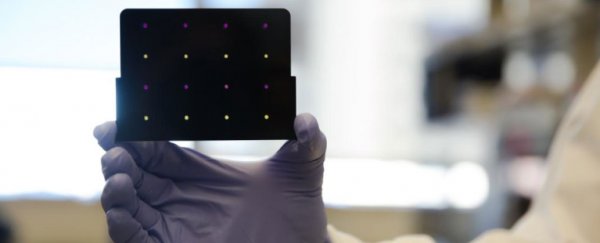While efforts to create a vaccine for Zika virus are ongoing, they're not there yet, which means one of the most effective tools we've got to contain the infection are diagnostic measures that let scientists keep tabs on where Zika is turning up.
And now an international team of researchers led by Harvard University has come up with what could be the best tool yet – a fast, low-cost diagnostic system for strain-specific detection of Zika, which could one day be used in the field to diagnose the virus using blood, urine, or saliva samples in a matter of hours.
"The growing global health crisis caused by Zika virus propelled us to leverage novel technologies we have developed in the lab and use them to create a workflow that could diagnose a patient with Zika, in the field, within 2–3 hours," said synthetic biologist James Collins from Harvard.
The technique, which in testing successfully detected live Zika virus in blood plasma from an infected macaque in just over 3 hours, is based on a previous system developed by Collins and fellow researchers to diagnose Ebola.
That system featured a synthetic biomolecular sensor designed to screen for specific RNA sequences. These inexpensive sensors – which change colour in the presence of the virus – can be embedded in small paper discs for just US$1 each.
And they're not limited to screening for Ebola either – they can detect other RNA viruses, including SARS, measles, influenza, hepatitis C, and West Nile fever.
But one of the challenges of detecting Zika with the paper sensors is that the virus appears in extremely low concentrations in blood, urine, and saliva. To get around this, the new system first amplifies the sample's RNA using a mixture of enzymes and primers that effectively boost the signal of the virus.
Once the virus has been amplified, the paper sensor then changes colour if there's a match, so a tester can visually identify if a sample contains Zika. An electronic reader can then analyse and quantify the viral load for a more detailed analysis.
The system also incorporates a CRISPR-Cas9-aided mechanism that can differentiate between specific Zika strains at a genetic level.
"We have tested our diagnostic systems against closely-related strains of the Dengue virus and found that within the first two steps, our system can readily distinguish Zika from Dengue," said one of the team, Alexander Green from Arizona State University. "The addition of the third CRISPR-based step – deploying Cas9 on a paper-based platform for the first time – only enhances the accuracy of detection. As we prepare this technology for translation, we plan to validate our system against dozens or even hundreds of clinical samples."
On top of the low cost of the test components, the system, which could be tailored to detect any RNA-based pathogens, can be freeze-dried before transport. The researchers say specific test kits could be designed and shipped to the site of infection outbreaks on demand.
"In response to an emerging outbreak, we envision a custom-tailored diagnostic system could be ready for use within one week's time," said Collins. "We are currently pursuing multiple opportunities to secure private and public funding in order to commercialise this diagnostic system and make it available to the world's health responders."
What's so heartening about the diagnostic tool isn't just that it appears to be an effective and inexpensive way to screen for Zika quickly. It's that the scientists who came up with it – a disparate group of researchers working at seven different universities across the US and Canada – pooled their resources so rapidly (in just six weeks) to come up with a solution.
Given the grim tidings we're used to hearing about Zika, it's awesome to be able to report some positive news on the subject for a change.
"We're a group of academics who are not set up to do this, but we dropped everything and pulled it together," said Collins. "A team from industry or a government lab, set up to do this, could have this going in less than a week. That's the potential of this synthetic biology platform."
The findings are published in Cell.
